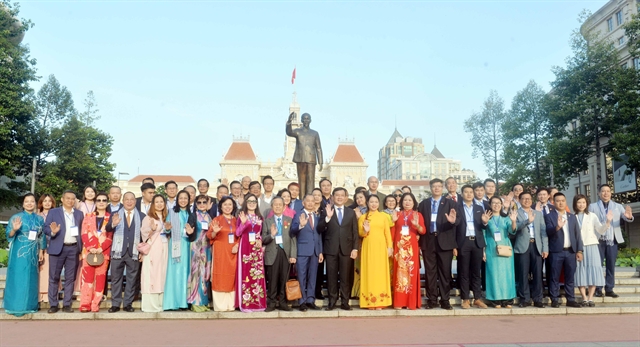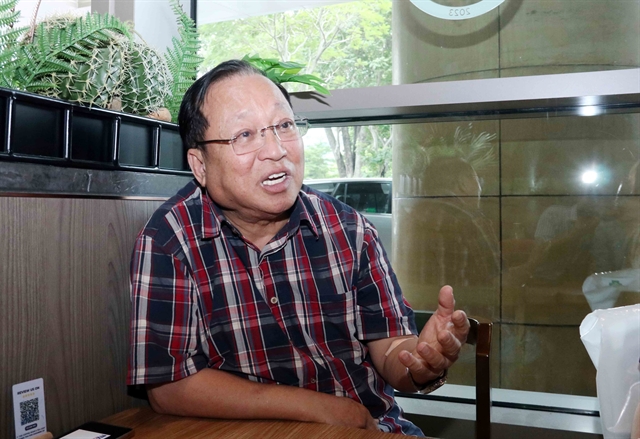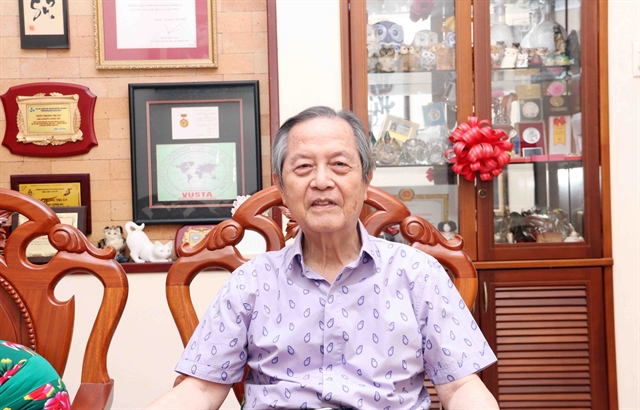Marking fifty years since reunification, Việt Nam honours a legacy of healing and unity, as overseas Vietnamese return to contribute, embodying the nation's enduring journey of reconciliation and shared identity.

Representatives of Vietnamese diaspora pose for a photo after paying tribute to President Hồ Chí Minh in front of HCM City Hall. VNA/VNS Photo Xuân Khu
The flag of the National Front for the Liberation of South Việt Nam flew atop the Independence Palace in Sài Gòn on April 30, 1975, signalling the end of a long and painful war, and marking the reunification of a divided country after more than two decades.
That triumphant moment etched in national memory began a new chapter—one of reconciling, rebuilding and healing the wounds of the past.
Half a century later, Việt Nam's journey toward national reconciliation continues to be exemplified by the voices of those who once fled, but have now returned to live, work and contribute to the national cause.
The consistent policy and commitment of the Việt Nam Communist Party and State to foster national harmony has, over the past 50 years, yielded substantial results. Reconciliation and reintegration have helped strengthen the great national unity bloc, which now serves as the cornerstone of the country's rapid development.
In the years following the war, many Vietnamese left the country due to different circumstances. Yet, each year, thousands of diasporal Vietnamese return to visit and many resettle and work in their homeland. This steady flow back is living proof of the spirit of unity that now defines the nation.
Architect Nguyễn Hữu Thái, now 87, was a witness to history. He saw the liberation army tank crash through the gate of the Independence Palace and helped deliver the surrender statement of President Dương Văn Minh of the Republic of Việt Nam on Sài Gòn Radio on that historic day.
After time living abroad and gaining Canadian citizenship, he later returned and reclaimed his Vietnamese nationality. His most indelible memory of April 30, 1975 was the moment when renowned songwriter Trịnh Công Sơn sang Nối Vòng Tay Lớn (Joining Hands) in a spirit of peace and solidarity.
"The song lyrics—about connecting forests to oceans and joining hands across the land—resonated deeply on that day," Thái recalled. "They symbolised the populace's desire for national reunification and the Vietnamese people coming together under one roof."
The journey to rebuild wasn’t easy, but looking back, Vietnamese both at home and abroad have every reason to take pride in what has been achieved. From economic reform to advancement of diplomacy, security and society, Việt Nam has made remarkable progress. This success, Thái said, reflected a national effort to resolve conflict, erase hatred and march forward in peace and unity.

Hà Tôn Vinh, a Vietnamese expert in economics and finance living in the United States, talks about his journey of returning to contribute to the country’s development. VNA/VNS Photo Xuân Khu
Đặng Lương Mô, 89, an expert in microelectronics, returned from Japan in 2002 and has since dedicated himself to education and technology development in Việt Nam. Recognised with national honours for his contributions, Mô believes that reconciliation is the natural path for any nation after war.
"The weapons have long gone silent. Those who once held rifles are now elders. We share blood, language and heritage—why wouldn’t we reconcile?" he asked. "My only concern has ever been how to give back."
From the United States, Hà Tôn Vinh, a former White House advisor under President Ronald Reagan, also returned to Việt Nam and is now a well-respected figure in the country’s finance and banking sectors. To him, April 30 represents not just the end of a war, but the start of a unified journey.
"I was successful in America, but I came back to contribute to national development because I’m Vietnamese," Vinh said. "The world now sees Việt Nam as a rising economy. That’s the fruit of reunification."
Their stories are deeply personal yet emblematic of a greater narrative, of people who, once scattered by conflict, now return with open hearts and eager minds. Whether through academia, arts or investment, they reaffirm Việt Nam's open-armed approach to reconciliation and concord, and the enduring truth voiced by President Hồ Chí Minh: "The country of Việt Nam is one, the Vietnamese nation is one."

Professor Đặng Lương Mô, a Vietnamese expatriate in Japan, is a scientist who has made significant contributions to the development of Việt Nam’s semiconductor industry. VNA/VNS Photo Xuân Khu
This philosophy is enshrined in a March 2004 resolution by the Việt Nam Communist Party on Vietnamese diaspora affairs, which calls for the removal of prejudice and division, and the promotion of openness, understanding and solidarity.
"All Vietnamese, regardless of ethnicity, religion, social status, origin, or reason for living abroad, who wish to contribute to the national cause, must be united in the great bloc of national solidarity," says the resolution.
That spirit is more than words. Today, over 400 projects of the Vietnamese diaspora worth nearly US$2 billion are active in Việt Nam. Hundreds of overseas intellectuals have returned to work long-term, and diasporal remittances reached US$16 billion in 2024.
In the quiet, heartfelt reflections of Thái, Mô and Vinh, we see the enduring bond between people and the land, the undying devotion of Vietnamese people to their motherland and the success of Việt Nam's policy of reconciliation.
It is a path paved not only by policy, but by human connection and by the unbreakable thread of a shared identity. VNS